Behind the Scenes of Booster Fun for Adventures in the Forgotten Realms
The Summer of Legend is in full swing, and the theme of nostalgia is flowing strong throughout it. When you talk about legends, you're talking about memorable stories from the past. Magic has almost 30 years of history for players. Dungeons & Dragons has that depth too, with more than 45 years under its belt.
How epic is it that these two now meet on Magic's terms?
This summer, we get to enjoy Dungeons & Dragons: Adventures in the Forgotten Realms, and this set's Booster Fun variants will give players of both D&D and Magic a shot of nostalgia as it forges a legend of its own!
Meet the Team
These two games seemed destined to meet one day, but it has taken a while to happen. "We were really excited," said Chrissy Wiley about the team's reaction to working on the crossover. "We love the classic D&D artwork style, and it was fun to see how we adapted and updated that for Magic."
"Remembering the classic monster manuals I had as a kid and poring through the pages was a big draw," said Tom. "I wanted to make that!"
Developing the card treatments for Adventures in the Forgotten Realms required a team with a keen eye for what makes the look and feel of D&D, drawing from across its history and versions, and how that could be translated into Magic. That team was headed up by Senior Creative Director Jess Lanzillo and Creative Manager Tom Jenkot. UX Designer Daniel Holt created all functionally unique frames like dungeon cards, and Tom and former Senior Graphic Designer James Arnold handled Booster Fun treatments.
A squad of digital artists helped make the art in this set look amazing, including Kevin Yee (who also does color correction work for the D&D team) and Silvia Cortese who led the set through card production, and Brandon Bailey who translated frame concepts into their finished look for print, keeping to the classic hand-rendered D&D look everyone loves. Creative Production Manager Chrissy Wiley organized the wealth of creative work that went into Adventures in the Forgotten Realms.
It was a full party that tackled one of the biggest adventures in Wizards history.
A Dragon's Hoard of Treatment Ideas
"So many people worked on the card treatments," said Tom, but the process began with brainstorming between Tom, James Arnold, Daniel Holt, and Senior Game Designer James Wyatt.
What came out of that session? "Tons of ideas! Pages and whiteboards of ideas! Since D&D has such a rich history, there were too many ideas. It was hard to pick."
The team eventually settled on two: the classic module and rulebook treatments. "Everyone quickly agreed that the two we landed on were best," said Tom. "All those other ideas are still hanging around—maybe we'll use them someday."
A nostalgic Dungeons & Dragons feel was the goal for the treatments. "It was so important to get the right look for the module and rulebook cards to evoke the right feel for D&D," said Chrissy. "We did several rounds of color builds and foil treatment testing until we got just the look that Tom wanted."
Showcase: Rulebook Art Treatment
This showcase rulebook art treatment is inspired by the great black-and-white art styles from the original Dungeons & Dragons books and manuals. You'll find 51 rulebook art treatments in the set—in Draft, Set, and Collector Boosters—each featuring new art in that classic style.
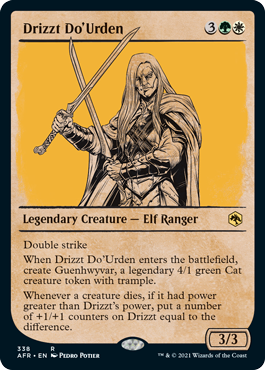
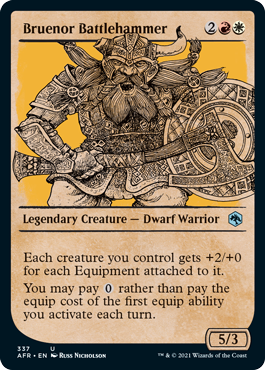
"The pen-and-ink style art for Adventures in the Forgotten Realms was unlike anything we had done in Magic before, so we had to come up with a treatment that served the art and was still scalable for a large volume of cards," said Chrissy. "We ended up with a somewhat simpler style than other Magic sets so it wouldn't compete with the art or make it look too modern."
Part of the visual impact of the rulebook card treatment is that simplicity, but they were not simple to create. The art had to hit "the right fidelity in the line work, in black and white only, with the single-character focus, and it had to be readable at card size," said Tom.
Selecting artists to match this aesthetic was a no-brainer in some cases. "I hired D&D artists that did these drawings from way back," said Tom. "Jeff Dee, Diesel Laforce, and Russ Nicholson all did it back in the day! So cool to work with these artists."
Newer artists, too, were tapped to create art in the classic style. "I brought on others that did this cool style naturally. (And thanks to Bree Heiss for taking on the second wave of these commissions!) Justine Mara Anderson, along with newer names to Magic like Pedro Potier, Phil Stone, and Justine Jones" were among the rulebook card treatment artists. Secret Lair series fans will recognize Justine Jones from the Kaleidoscope Killers drop.
A Wash of Color
The work on the rulebook card treatments didn't stop there. "We couldn't just do black-and-white cards to match the old monster manuals," said Tom, "so what could we do that seemed authentic and still be like a Magic card?"
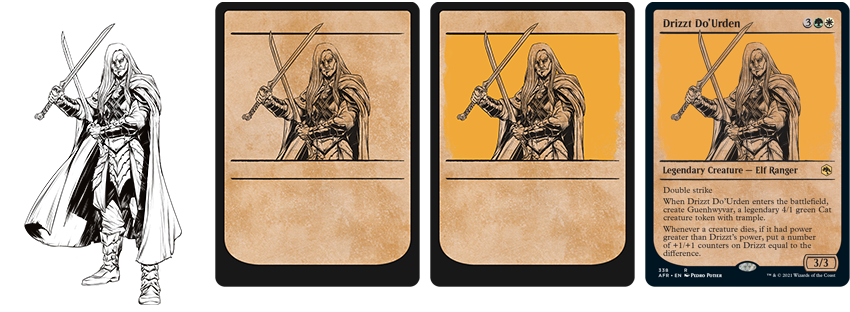
"We quickly landed on a parchment, toyed with the font, and the crop," continued Tom. "This treatment required a lot from our in-house team since the artists were sending in bitmap black-and-white drawings."
Some of this work involved color—specifically working with a card's color identity and that parchment appearance.
"For the D&D rulebook card treatment, we couldn't apply the standard color treatment," said Tom. "The original inspiration was black-and-white drawings, so any color seemed strange. But we needed it and decided, to make it look cool, to lean into big color washes behind the characters that were adjacent color-wise to some of those retro D&D colors.
"It landed in a really cool space, and I have to credit James Arnold, and digital artists J. Lonnee, Silvia Cortese, and Kevin Yee with getting these to look so good."
Showcase: Classic Module Treatment
Land gets special treatment in Adventures in the Forgotten Realms unlike any we've seen in the past. If you've bought or played a D&D adventure published between the late 1970s through the 1990s, you're probably familiar with the term "module" used on these products. You may even be picturing one of those in your mind right now.
Hold that image, and then get ready to be transported back a few decades.
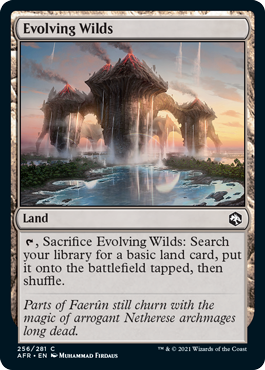

This showcase card treatment just radiates classic D&D, and you'll find nine of them in Draft, Set, and Collector Boosters.
"The dungeon module card treatments had many, many versions," said Tom. "At first, we were trying to make sure they were Magic cards first and look like modules second. But every early version felt like a compromise. We had to just pick an era and go for it.
"The colors of these modules were what settled it—so bright and bold! I made sure to collect all the old module covers to draft off those colors. This had to look authentic!"
These module card treatments feature all-new artwork from some of the best-known classic Dungeons & Dragons artists.
"It's a bit of time machine effect," said Tom. "Larry Elmore's was the first fantasy art I'd ever seen (on Dragonlance novels). I stared at those covers for a long time in my youth.
"I made a wish list with the help of other D&D fans and reached out to the artists. It was surreal talking with many of them. Getting Erol Otus on the project was a dream also. Brian Snoddy, Tony DiTerlizzi, Jeff Easley, Ralph Horsley, Adam Rex, Chase Stone, and Wayne Reynolds—all so good. All the artists were delighted to be working on the first Magic set themed after D&D, and I was delighted commissioning all of them and seeing their work coming to life!"
With artists selected, art descriptions were sent—"thanks to Annie Sardelis for perfect art descriptions," said Tom—and the team had the enviable experience of watching amazing artwork come together for the set.
Oh, and what's the story behind those module numbers on these card treatments?
"One of the cool things here are the module codes in the top left," said Tom. "We used the letters that matched the rarity, which, coincidentally, were already used in previous vintage D&D modules. I worked with Nathan Stewart on the D&D team on where to start the numbers. We came up with the plan to start with the next number in the sequence, as if these were new modules in the same product line. So cool."
Giving Dragons Their (Borderless) Due
You can't have Dungeons & Dragons without the dragons, and when you're making Dragon cards in Magic, you have to give these apex monsters their due—especially if they happen to be named Tiamat.

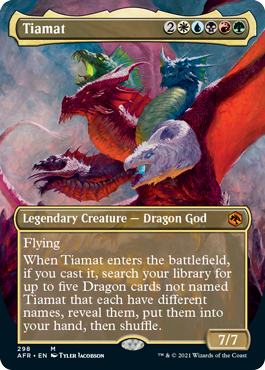
Twelve Dragons get gorgeous borderless treatments in Adventures in the Forgotten Realms. There are also five planeswalkers with borderless treatment, and all seventeen of these cards can be found in Draft, Set, and Collector Boosters.
Extended-Art Cards
There are 93 total rare and mythic rare cards—56 from the four Adventures in the Forgotten Realms Commander decks and 37 from the Adventures in the Forgotten Realms set—that feature extended art in the set. You can find these exclusively in Collector Boosters.
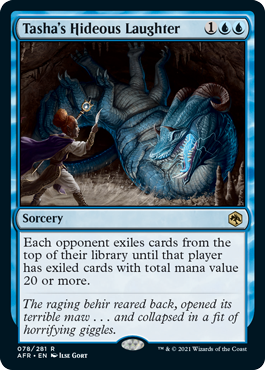

Beyond the Booster Fun
There's even more going on in Adventures in the Forgotten Realms. To create that Dungeons & Dragons feel in Magic, new elements have been introduced to the game that have corresponding visual design to bring them together.
Basic Lands with Flavor Text
We talked earlier about the classic module treatment for lands in Adventures in the Forgotten Realms, so we can't leave out another new feature for lands in the set: flavor text on basic lands. While not a card treatment in the strictest sense, this is something new in Magic.
"I'm not sure where or when this idea first came about," said Daniel, "but I do remember our director of game design, Brady Bell, coming up to me after a meeting and asking: 'Have we ever put flavor text on a basic land?' I said we hadn't."
Brady: "Can we?"
Daniel: "Sure!"
Sometimes history is made that easily.

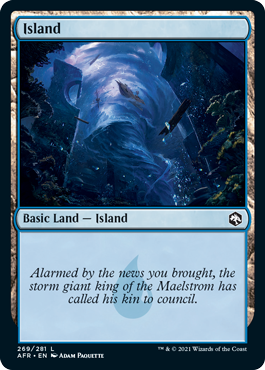
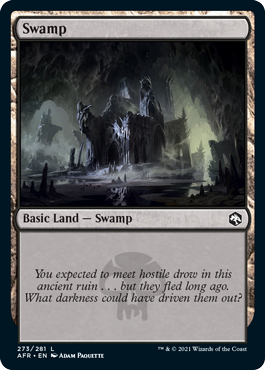

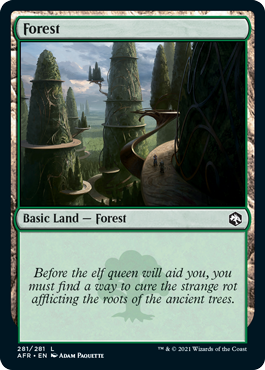
"Storytelling is so important in a D&D session," said Daniel. "Putting that evocative type of dialogue on cards required to play a game of Magic just made sense. The concept was such a natural fit that it came together quickly, and folks were surprised we'd never done it before!"
Monster Stat Art Cards
Art cards also get something new in Adventures in the Forgotten Realms. "Magic sets bring with them a delightful amount of new art each release," said Daniel. "We normally showcase a select group of them using our Artist Series cards in Set Boosters. But this is a Dungeons & Dragons set! What if those cards were player aids for that game as well? That's what Senior Creative Director and avid D&D player Jess Lanzillo asked.
"Enter monster stat card backs."
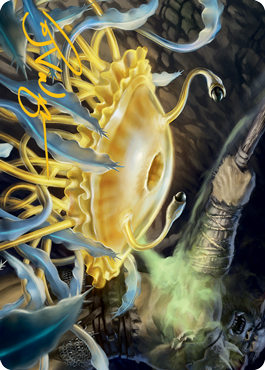
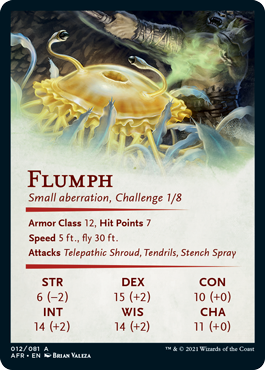
"The cards' look and feel is a direct pull from the Monster Manual, achieved by using similar fonts, colors, and layout, while featuring that gorgeous new art commissioned specifically for Adventures in the Forgotten Realms. Magic players will see these monsters appear throughout the set, and these collectible cards provide a glimpse into their Dungeon & Dragons gameplay counterpart."
Adventure in the Forgotten Realms has 27 art cards featuring monster stats on the back, both regular and artist signature versions, and are found exclusively in Set Boosters.
Dungeon Cards
Just as dragons are essential to the D&D experience, so, too, are dungeons. Many tabletop D&D players are familiar with playing on a grid layout—whether it be as simple as a piece of graph paper or as elaborate as a dry-erase board or rolled-out piece of vinyl—and the dungeon cards in Adventures in the Forgotten Realms introduce this to Magic.
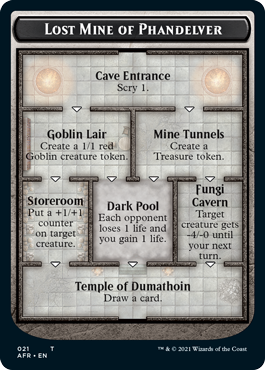


"When exploring the world in a game of Dungeons & Dragons, the grid plays a vital role in that experience," said Daniel. "Moving your character, attacking enemies, claiming spoils
"I pitched the user interface (as a very basic wireframe) for this new mechanic early on, and folks were immediately drawn to the customizable layout and decision-making that hearkens back to the D&D version of exploration. We were even able to pull some existing room objects and textures from D&D for that authentic feeling!"
Ready to begin your own journey with Adventures in the Forgotten Realms? The set will be available in MTG Arena and Magic Online beginning July 8. Prerelease week starts on July 16 and continues through July 22, with worldwide release in your local game store on July 23.

